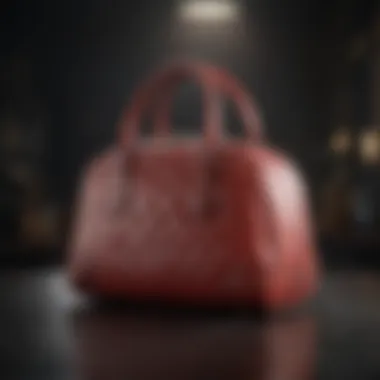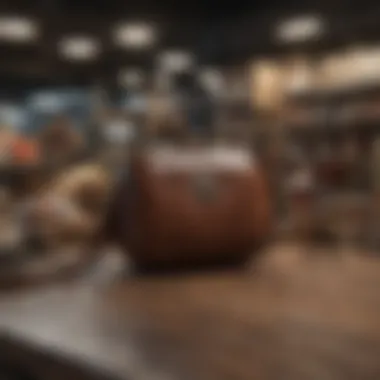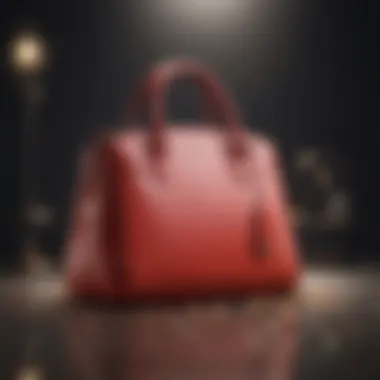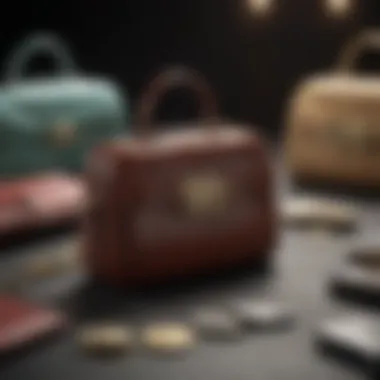The Economics of High Price Purses and Their Impact


Overview of the Topic
High-price purses represent more than just fashion statements. They embody a complex interplay between economics and consumer behavior. These luxury items often serve as symbols of status and wealth, attracting a diverse range of consumers. Notably, the overarching significance of these products tends to go beyond their functionality.
Definition and Importance of the Topic
High-price purses are typically crafted by renowned brands like Louis Vuitton, Chanel, and Hermes. Their value is not solely linked to materials or craftsmanship; it also encompasses brand perception, exclusivity, and heritage. Understanding the economics surrounding these products is crucial for grasping the dynamics of the luxury market. Additionally, these purses are increasingly seen as investment vehicles, offering potential returns akin to traditional financial assets.
Key Benefits and Implications
Investing in high-price purses can yield several benefits. First, certain models appreciate over time, allowing owners to capitalize on their investments. Second, the ownership of such items can enhance social status, creating networking opportunities. Lastly, engaging in this market can stimulate broader discussions about consumerism, sustainability, and the social implications of luxury goods.
Exploring Strategies and Tips
A successful engagement with high-price purses requires practical strategies. To maximize investment potential, consider the following recommendations:
- Research Models: Familiarize yourself with models that retain or grow in value. Popular pieces often exhibit substantial appreciation.
- Market Trends: Stay informed about fashion trends. Certain designs may surge in popularity, correlating with social media influences or celebrity endorsements.
- Care and Maintenance: Preserving condition can significantly impact resale value. Invest in proper storage and maintenance tools.
Case Studies and Examples
Examining successful transactions offers insights into the market dynamics of high-price purses. Consider the resale of a limited-edition Louis Vuitton handbag. Initially priced at $2,000, it sold for $4,500 after five years. This case highlights how limited availability and brand prestige can inflate value. However, not all models appreciate. For example, certain seasonal collections by popular brands may see diminished interest post-launch, demonstrating potential pitfalls in impulsive purchasing decisions.
Comparison of Financial Products
The luxury purse market can be likened to traditional investment products, although each has distinct features. Below is a comparison:
| Investment Type | Pros | Cons | | Luxury Purses | Potential for appreciation | Market volatility | | Stocks | Dividend income | Risk of loss | | Real Estate | Tangible asset | Illiquid |
Understanding these comparisons helps in making informed decisions.
Expert Insights and Recommendations
Experts suggest viewing high-price purses not merely as fashion items but as alternative investments. They often recommend the following:
- Diversification: Don’t rely solely on one brand or model. Spread your investments across various high-end products.
- Networking: Engage with communities focused on luxury goods. Platforms such as Reddit can provide valuable market insights.
- Analysis: Always assess the potential for future resale before making a purchase. Knowing which brands have a history of appreciation is key.
“Luxury items, when approached as investments, can offer a blend between enjoyment and financial return.”
Overview of High Price Purses
High price purses play a significant role in the luxury goods market. They are not merely fashion items, but they also carry economic weight and cultural implications. Understanding their importance helps to grasp the complexities of consumer behavior, brand dynamics, and broader market trends. In this section, we will explore the definition, classification, and historical context of high price purses to establish a solid background for further discussion in this article.
Definition and Classification
High price purses can be defined as luxury handbags that command a premium price due to factors such as their brand, craftsmanship, materials, and design. These items are often perceived as status symbols, making them sought-after possessions among affluent consumers.
Classification of high price purses can include:


- Designer brands: These are produced by well-known luxury labels such as Louis Vuitton or Chanel and are characterized by exclusive designs and quality materials.
- Limited Editions: Some purses are released in limited quantities, increasing their rarity and value, such as the Hermes Birkin bag.
- Vintage pieces: Older models that are no longer in production can appreciate in value over time, contributing to their allure in the investment market.
This classification not only helps to identify the different types of purses but also exposes the reasons behind their high prices and desirability among consumers.
Historical Context
The history of high price purses is intertwined with the evolution of fashion and luxury. Luxury handbags began to emerge in the late 19th century, initially serving practical purposes. However, as fashion evolved, so did the handbag’s role in society.
Key historical moments include:
- The introduction of the modern handbag in the 1920s, which marked the shift from functional items to fashion statements.
- The post-World War II era, where brands like Gucci and Prada began to define luxury, influencing consumer demand and setting the stage for future trends.
- The rise of social media in the 21st century, which transformed how luxury items are marketed and consumed, amplifying their desirability.
Understanding this historical context provides insight into how high price purses maintain their position in the luxury market and highlights the evolving dynamics between brands and consumers.
Market Dynamics
Understanding the market dynamics surrounding high-price purses is crucial for discerning their place within the luxury goods sector. This topic examines how various elements interact to influence demand, supply, and overall consumer behavior in this niche market. Analyzing market dynamics not only unveils the underlying forces that affect pricing but also provides insights into consumer preferences and purchasing trends. Such an analysis is pertinent for investors and personal finance enthusiasts considering the implications of luxury goods on wealth accumulation and investment diversification.
Demand and Supply Factors
Demand for high-price purses is typically driven by a combination of socio-economic status, consumer preferences, and brand appeal. Wealthier individuals often seek luxury items as both a personal statement and a sign of affluence. On the supply side, exclusive partnerships and limited production runs contribute to the perceived scarcity of certain handbag models. This scarcity can elevate demand further, creating a cycle where high prices become a hallmark of desirability.
Several factors influence the demand for these luxury items:
- Income Levels: Higher disposable income allows consumers to indulge in luxury goods.
- Cultural Influence: Social norms often dictate a preference for luxury; as such items become status symbols, their demand rises.
- Marketing Strategies: Effective advertising and celebrity endorsements increase brand visibility and consumer interest.
Conversely, the supply side reflects:
- Production Costs: Luxurious materials and artisanal craftsmanship often elevate production costs, which subsequently impacts retail prices.
- Brand Strategy: Brands like Hermès and Chanel carefully manage production quantities to maintain exclusivity, thus affecting availability and desirability.
Role of Brand Identity
Brand identity plays an instrumental role in shaping consumer perceptions and market behavior regarding high-price purses. Established brands such as Louis Vuitton or Gucci have developed robust identities that connote prestige and high status. This established identity is essential as it cultivates trust among consumers and assures them of quality and exclusivity.
The key elements of brand identity include:
- Heritage and Narrative: Brands often leverage their historical significance to strengthen consumer loyalty.
- Visual Brand Elements: Logos, color schemes, and design aesthetics create immediate recognition and influence purchasing decisions.
- Customer Experience: A luxurious shopping experience enhances brand perception and creates a deeper emotional connection with consumers.
Brands must continuously innovate while preserving their core identity to sustain their market position. This balance is paramount, as failure to adapt can result in a shift in consumer interest toward emerging brands offering freshness and vibrancy.
Seasonal and Fashion Trends
The high-price purse market is significantly influenced by seasonal trends and fashion cycles. Luxury brands typically release new collections in alignment with fashion weeks and seasonal transitions. These introductions can create a sense of urgency among consumers, who may be compelled to purchase to stay in vogue.
Several constant factors shape these trends:
- Fashion Cycles: Handbags often reflect the prevailing styles in apparel, which are dictated by fashion designers and influencers.
- Cultural Events: Events such as awards shows can spike interest in celebrity-endorsed brands, impacting sales trends.
- Sustainability Movements: As consumers become more environmentally conscious, brands that align with sustainability claims may see a rise in popularity, influencing purchasing behaviors.
Therefore, an understanding of seasonal influences and fashion trends is vital in predicting potential investment opportunities within this market.


By analyzing the market dynamics, stakeholders can better navigate the complexities of purchasing and investing in high-price purses, ultimately contributing to informed decisions in personal finance.
Consumer Psychology
Understanding consumer psychology is essential for grasping the intricate dynamics that govern high-priced purses and their ownership. It encompasses how consumers think, feel, and act toward luxury items. In the realm of high-price purses, perception plays a crucial role. Consumers often associate these products with exclusivity, prestige, and a social status that goes beyond the mere functionality of the item. This perception shapes the purchasing decisions of affluent individuals and forms part of the allure that high-priced purses hold.
Perception of Luxury
The perception of luxury revolves around various factors including branding, scarcity, and craftsmanship. High-price purses, such as those from brands like Hermès or Louis Vuitton, often benefit from a deeply embedded brand identity that evokes notions of quality and indulgence. Consumers often perceive these items as more than just fashion accessories; they see them as symbols of personal success and achievement. This perception creates a value that transcends the material worth of the purse itself.
An interesting aspect of this perception is how it can differ across cultures. In some regions, luxury goods are considered essential for social standing, while in others, they might be viewed with skepticism. Such cultural nuances can significantly impact consumer behavior, making it important for brands to tailor their marketing strategies accordingly.
The Status Symbol Effect
High-priced purses serve as status symbols in multiple social contexts. The ownership of these items often signals financial success and social influence. When an individual carries a luxury purse, it can generate admiration and recognition from peers. This status symbol effect is a fundamental driving force behind affluent consumers' desire to purchase high-priced items.
Moreover, brands often leverage this psychology by emphasizing limited editions or exclusive collections. This scarcity fuels demand as consumers aspire to possess what others cannot easily access. As a result, the resale market for these products thrives, making them not just fashion statements but also investment opportunities.
Consumer Identity and Ownership
Consumer identity is closely intertwined with ownership of high-priced purses. Owning a luxury item frequently influences how individuals perceive themselves and how they wish to be perceived by others. A designer purse can reinforce a consumer's self-image or represent an aspiration. This phenomenon contributes to a deeper emotional connection with the item beyond its physical attributes.
Furthermore, the act of purchasing high-price purses entails a narrative construction where the consumer becomes part of the larger story of the brand. This narrative often includes themes of heritage, craftsmanship, and lifestyle, augmenting the perceived value of the product.
"The emotional connection consumers form with luxury items can lead to lasting brand loyalty, influencing future purchasing behaviors."
Investment Potential
The investment potential associated with high price purses is a topic that resonates with both buyers and investors. As luxury goods, these items often extend beyond mere accessories and embody a financial asset with the capacity for appreciation. Understanding the dynamics of this market can provide insights not only into consumer behavior but also into practical investment strategies. When evaluating high price purses for investment purposes, several specific elements come into play.
Resale Value Analysis
When considering high price purses, one of the primary factors is resale value. Certain brands like Hermès, Chanel, and Louis Vuitton maintain strong resale markets. These brands have a long-standing history though are often limited in their supply, which drives up their demand and market value. Research indicates that some luxury purses can resell for more than their original purchase price, sometimes significantly so. For example, the Hermès Birkin bag is known for its high resale value and some models have appreciated to two or even three times their original prices. Factors that influence resale value include:
- Brand Recognition: The reputation of the brand plays a crucial role in determining resale. Consumers are often willing to pay a premium for well-known brands.
- Condition of the Item: Well-maintained bags retain value better than those showing wear and tear.
- Limited Editions: Limited releases tend to attract higher resale prices due to scarcity.
- Market Trends: Fluctuations in the luxury market can affect how much buyers are willing to pay for a specific purse.
Long-term Value Retention
The concept of long-term value retention also deserves examination. High price purses are not merely trends; rather, they often represent an investment in a timeless accessory. Unlike other luxury items, which can depreciate quickly, high-end purses frequently hold their value well over time. In some cases, they appreciate even further. This retention can be attributed to various factors:
- Historical Significance: Many high-priced purses come with a rich history and heritage, enhancing their allure.
- Cultural Capital: Ownership of a high price purse can imply status, which can sustain its desirability.
- Market Stability: Luxury markets, while susceptible to economic downturn, tend to stabilize quicker compared to other market segments.
Sustainability and Ethics
In understanding high price purses, the topics of sustainability and ethics emerge as crucial areas of investigation. The luxury fashion industry has been under scrutiny for its environmental footprint and labor practices. This scrutiny is not merely a trend, but rather a reflection of a growing consumer awareness regarding the implications of their purchases.
High price purses often symbolize more than just luxury; they can also be viewed through the lens of responsibility and ethical consumerism. A significant segment of the target audience for these products is increasingly interested in the origin of materials, the production processes, and the companies' commitment to ethical practices. As such, sustainability and ethics are vital dimensions in the economic discussion surrounding luxury goods.


Environmental Impact of Production
The production of luxury handbags has a substantial impact on the environment. From sourcing raw materials to manufacturing processes, every step can contribute to pollution, resource depletion, and waste generation. For instance, the leather industry is notorious for its environmental concerns. Tanning processes typically require toxic chemicals that can contaminate water sources. Synthetic alternatives, while often marketed as eco-friendly, may have their own set of environmental problems, such as reliance on fossil fuels.
Brands like Stella McCartney have taken initiatives to utilize sustainable materials and ethical practices. This shift not only appeals to environmentally conscious consumers, but also sets a precedent for the entire industry. By adopting sustainable production methods, high price purse brands can significantly mitigate their negative ecological footprint.
Labor Practices Within the Industry
Labor practices in the luxury bag industry raise ethical questions that cannot be overlooked. Many high-end brands outsource production to countries with lower labor costs. Unfortunately, this can result in exploitative working conditions, including inadequate wages and unsafe environments. High-profile cases of labor abuse have prompted consumers to reconsider where their money goes.
Brands like Gucci and Hermès, have begun to promote transparency in their labor practices. Initiatives to ensure fair wages and safe working conditions are becoming increasingly important to earning consumer trust. Collaborations with organizations that promote fair trade and certification by ethical standards can improve industry practices.
"Consumers are becoming more educated and concerned about labor practices in the luxury sector. In response, brands need to embrace accountability and transparency."
In summary, addressing sustainability and ethics in high price purses goes beyond mere compliance; it reflects a commitment to responsible consumption. As the market evolves, brands that prioritize these values will not only satisfy a growing demographic but also lead the way for future trends in luxury consumption.
Cultural Implications
Understanding the cultural implications of high price purses offers valuable insights into their role in modern society. Luxury items such as these do not exist in a vacuum; they reflect and influence cultural trends and societal values. The significance of high price purses extends beyond mere aesthetics or functionality; they are symbols of status and identity.
Global Perceptions of Luxury Goods
Luxury goods evoke varied perceptions across different cultures. In some societies, owning a high price purse is a mark of prestige and success. It signifies wealth and social standing. For instance, brands like Hermès and Chanel are often associated with exclusivity. Their bags are not just accessories but representations of affluence. Moreover, the global luxury market is shaped by geographic variations. In emerging markets, consuming luxury goods can also signal modernity and aspiration toward a global lifestyle.
The purchase of luxury goods may carry different meanings in Asian countries compared to Western nations. In countries such as China, there is a deep-rooted culture of gifting luxury goods. This practice manifests the concept of ‘face’—a cultural notion involving respect and social standing. Owning a high price purse can thus reinforce personal and familial honor.
Influence of Social Media
Social media plays a crucial role in shaping consumer perceptions and behaviors. Platforms such as Instagram and Facebook facilitate rapid dissemination of trends and consumer narratives. Influencers and celebrities often endorse high price purses, creating a social desirability around these items. The visual nature of social media makes wearing or displaying luxury goods highly impactful. Users share their possessions, generating a culture of visibility and desirability.
However, this influence carries implications for societal values. It can promote consumerism while also informing trends based on perceived scarcity and exclusiveness. Social media highlights how quickly perceptions can shift. A bag can gain immense popularity overnight, driven by posts from influential figures.
"Social media has fundamentally transformed the way high-priced luxury goods are perceived and consumed, creating both aspirational desires and competitive pressures among consumers."
Future Trends in High Price Purses
The high price purse market is evolving rapidly, influenced by various factors. Understanding future trends helps consumers, investors, and producers navigate a dynamic environment. Trends point to changes in consumer preferences, environmental consciousness, and technological advancements. These factors have implications not just for purse prices but also for brand positioning in the market.
Emerging Brands and New Markets
New brands are entering the high price purse market, challenging established players. Many of these brands focus on niche markets, targeting specific consumer segments. For example, there is a growing interest in sustainable luxury. Brands that prioritize environmentally friendly materials and ethical labor practices are resonating with younger, socially conscious consumers. These brands often offer unique designs that stand out in a crowded marketplace.
The emergence of new markets, particularly in Asia and Africa, adds further complexity. Consumers in these regions display growing interest in luxury goods. This trend presents opportunities for both traditional and new luxury brands. For instance, brands like Off-White and Jacquemus have gained popularity for their appealing designs and considerable social media presence.
Companies can benefit from engaging with these emerging markets through localized marketing strategies. This approach requires understanding cultural nuances and preferences, ensuring that products meet the specific demands of new consumers.
Technological Innovations in Design
Technological innovations are reshaping the production and design process of high price purses. 3D printing technology allows for unique, customizable designs. These innovations not only enhance design but also reduce waste in production. Brands can offer limited editions without the excess inventory that traditionally plagues luxury markets.
Additionally, augmented reality (AR) is emerging as a valuable tool for consumer engagement. By allowing shoppers to try on purses virtually, brands improve the buying experience. Customers can visualize how a purse complements their attire, reducing return rates.
Social media platforms too play a role in technological shifts. Brands are using artificial intelligence to analyze consumer data, tailoring their offerings according to trends detected through online behaviors. This adaptiveness is crucial in a fast-paced luxury market.
"The future of luxury fashion lies in the ability to innovate while maintaining a commitment to quality and sustainability."



